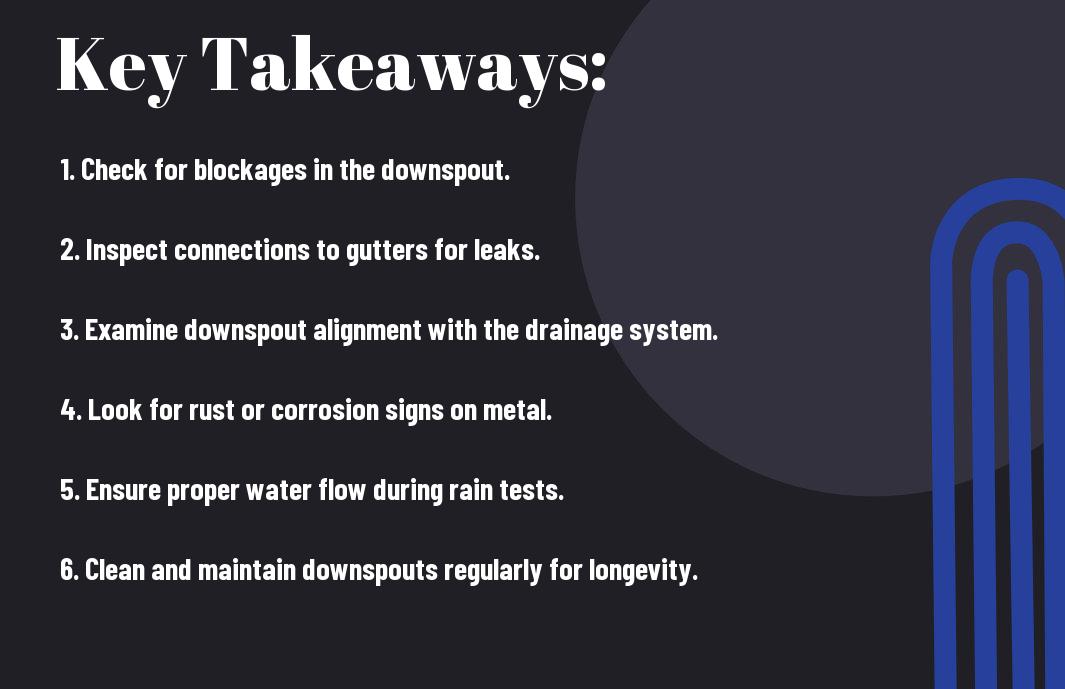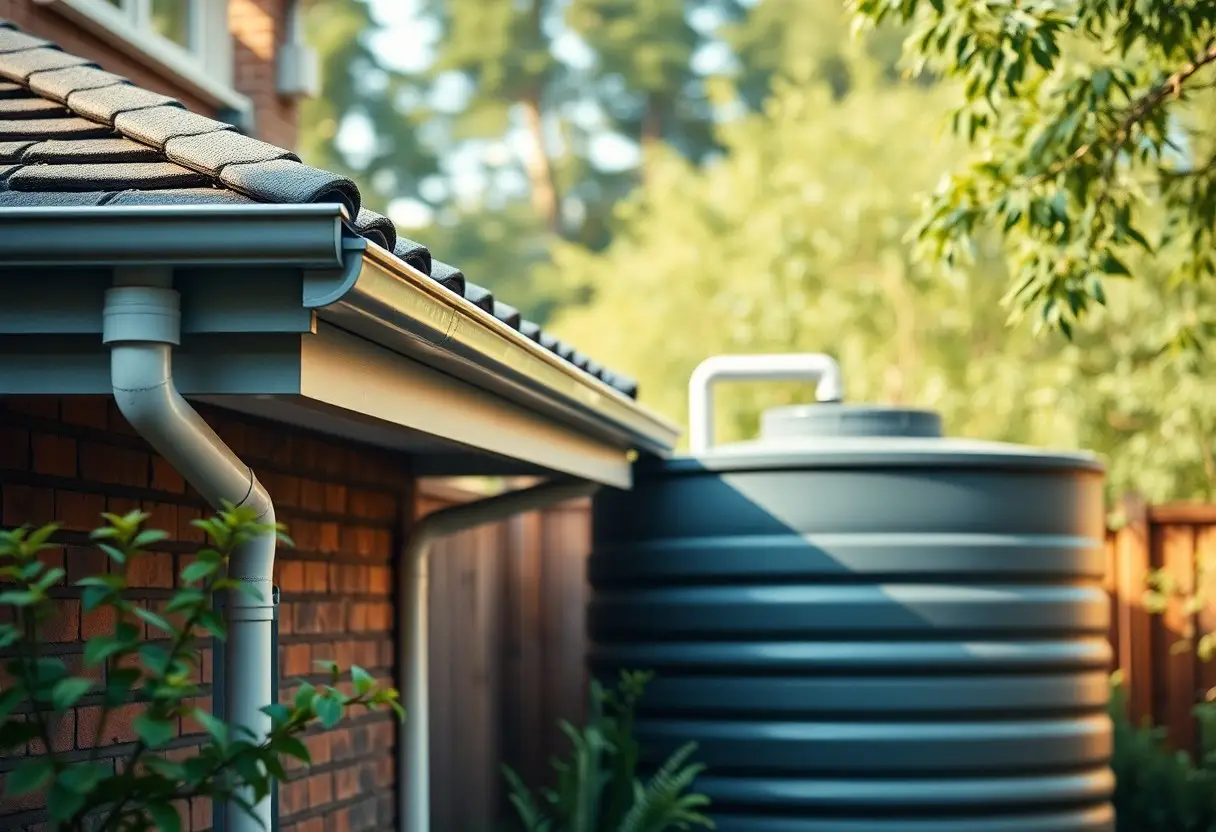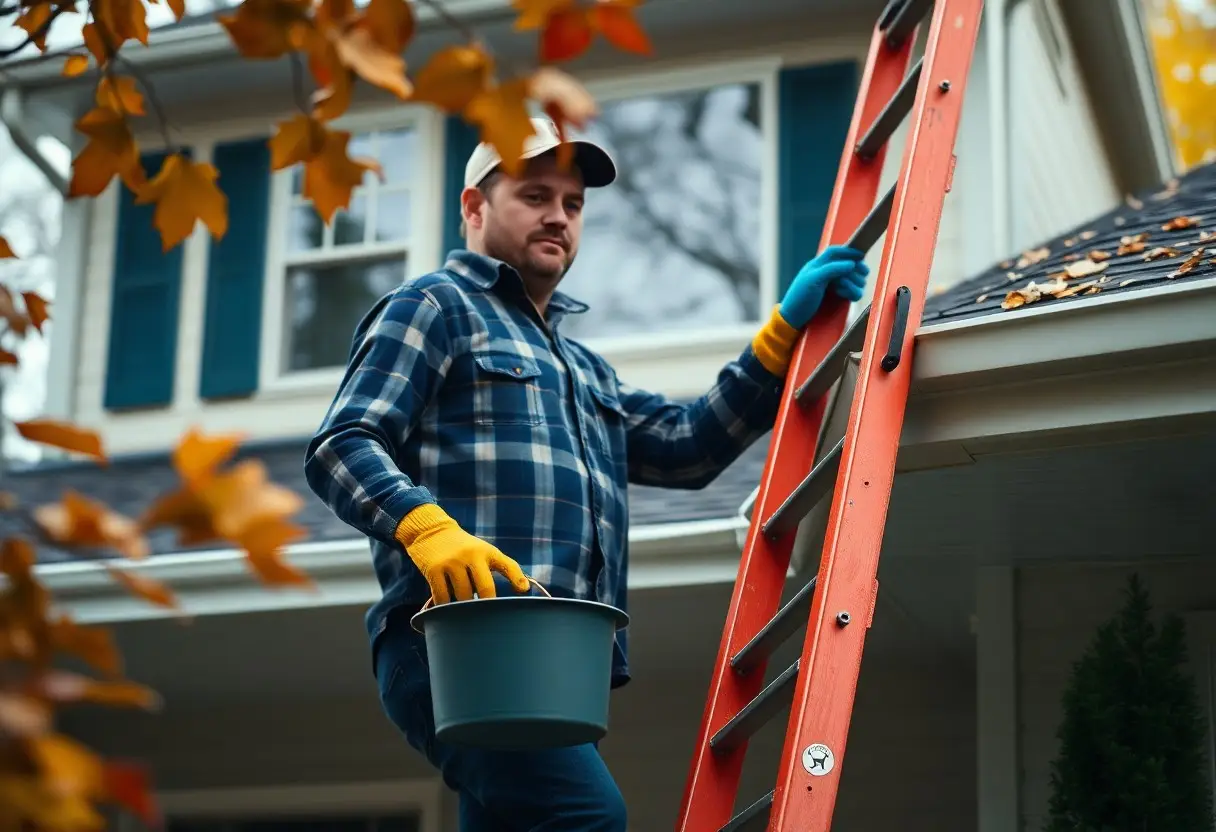Many homeowners overlook the importance of their downspouts, yet a proper inspection can prevent serious water damage. In just five straightforward steps, you can assess potential clogs and ensure optimal water flow away from your home. This proactive maintenance not only safeguards your foundation but also contributes to the longevity of your property. By following this guide, you will gain the expertise needed to keep your downspouts functioning efficiently and protect your largest investment—your home.
Key Takeaways:
- Begin your inspection by clearing any debris from the downspout and the area around its base to ensure proper flow and easy visibility.
- Check for any visible signs of damage or wear, including dents, rust, or loose connections that could affect performance.
- Test the downspout’s drainage efficiency by running water through it to identify any blockages or areas where water may pool.
Understanding Downspouts
A downspout is an important component of your home’s gutter system, designed to channel rainwater away from your roof and foundation. This prevents potential damage to your home while ensuring proper drainage and maintaining the structural integrity of your property. By redirecting water to a safe location, downspouts play a pivotal role in preserving your landscape and preventing pooling or flooding around your home.
Importance of Downspout Functionality
Importance of maintaining your downspout functionality cannot be overstated. When functioning properly, downspouts effectively divert rainwater away from your home’s foundation, minimizing the risk of water damage, mold growth, and soil erosion. A well-maintained downspout system helps protect your property, ensuring its longevity and value over time.
Common Issues with Downspouts
Functionality of downspouts can be compromised by various common issues that require your attention. Signs such as overflowing gutters, standing water, and stains on your home’s exterior may indicate blockages or misalignments. Additionally, clogs, often caused by leaves, debris, or even animal nests, can block the flow and lead to excess water pooling around your foundation. You should also monitor for any damaged sections or rust, as these can lead to significant drainage problems, increasing the risk of structural damage to your home. Keeping an eye out for these issues is important to ensuring your downspouts work effectively.

Tools Needed for Inspection
Any thorough downspout inspection requires the right tools to ensure you do the job effectively. Equip yourself with the importants before climbing that ladder, so you can identify potential issues and maintain your drainage system in optimal condition.
Basic Tools for the Job
Tools like a ladder, a flashlight, a bucket, and a trowel will serve you well during your inspection. A sturdy ladder will help you access high points, while a flashlight can illuminate dark areas within the downspout. A bucket is handy for collecting debris, and a trowel allows you to clear clogs efficiently.
Safety Equipment and Precautions
Against any potential hazards, you should prioritize your safety while performing a downspout inspection. To do this, wear non-slip shoes and use gloves to protect your hands from sharp debris. Additionally, consider wearing safety goggles to keep your eyes safe from flying particles.
Inspection is important for maintaining a safe working environment. Ensure your ladder is on stable ground and secured before climbing. Always keep your hands free for balance, and do not reach too far while on the ladder. Falling can result in serious injury, so it’s better to ask for assistance if necessary. Utilizing proper safety equipment makes all the difference, keeping you safe as you work on your downspouts.
Step 1: Visual Inspection
Despite its simplicity, a visual inspection is an vital first step in ensuring your downspouts function properly. Walk around your home, observing if there are any evident signs of wear, rust, or damage. Keep an eye out for missing parts or misalignments that could disrupt the water flow. Taking the time to inspect visually can save you from bigger issues down the line.
Checking for Blockages
One of the primary concerns during your visual inspection is to identify any blockages in the downspouts. Look for leaves, debris, or sediment that may hinder proper water drainage. Ensure that water can free-flow through the system, as clogs can lead to serious water damage.
Assessing Structural Integrity
On your inspection journey, also pay attention to the structural integrity of your downspouts. Check for signs of bending, cracking, or loose connections that may compromise efficiency. A strong structure is vital for effective water management and preventing overflow issues.
Plus, maintaining the structural integrity of your downspouts is vital for a healthy drainage system. A bent or cracked downspout can lead to serious leaks, risking structural damage or mildew in your home. Look for any signs of disconnect between sections, as this could not only obstruct flow but also result in erosion around your foundation. Keep your downspouts in good shape to protect your property and ensure proper rainwater management.

Step 2: Testing Water Flow
Not all downspouts are created equal. To ensure your drainage system is operating efficiently, you must test the water flow. During this step, you will identify any blockages or issues that may be affecting the flow. This simple process involves observing how water travels through your downspouts and determining if anything impedes its path.
Methods for Testing Flow
Methods for testing flow include utilizing a garden hose or conducting a rain simulation. By directing water into the downspout, you can observe if it drains smoothly or if any backing up occurs. This straightforward assessment allows you to see potential problems in real time.
Identifying Drainage Problems
After completing the flow test, it’s vital to identify any drainage problems that may have surfaced. Look for signs of water backup, which can indicate blockages within the downspout or the drainage system.
But it’s important to address these issues immediately. A backed-up downspout can lead to serious water damage to your home’s foundation and landscaping. Additionally, you might notice pests or mold growth around the affected areas. By thoroughly examining any irregularities during your water flow test, you ensure your home stays safe and protected from potential hazards.
Step 3: Inspecting Connections
Many homeowners underestimate the importance of checking the connections between your downspouts and gutters. A thorough inspection of these areas will help you identify any potential issues that could lead to water damage. Be on the lookout for any visible bends, kinks, or misalignments that could obstruct water flow. Proper connections should allow for efficient drainage, preventing potential flooding or erosion around your foundation.
Checking Joints and Seals
Inspecting your downspout joints and seals ensures that they are intact and functioning properly. Look for any signs of wear, such as gaps or cracks, which can compromise the system’s efficiency. A damaged joint could lead to leaks, allowing water to pool in unwanted areas, potentially damaging your home’s foundation.
Evaluating Downspout Extensions
Downspout extensions are critical for directing water away from your home. Make sure they are securely attached and functioning as intended. Check for any blockages or obstructions that could prevent the extension from directing water away effectively.
Seals and connections between your downspout and extensions are vital in preventing water damage. If your downspout extensions are not properly sloped away from the foundation, water can accumulate, leading to potential flooding and structural issues. Inspect these extensions for any cracks or unwanted bends that could disrupt drainage. Ensure that they extend far enough to redirect water away from your home’s foundation, providing you with a reliable barrier against heavy rainfall.
Step 4: Cleaning and Maintenance Tips
For effective downspout inspections, it’s crucial to establish a cleaning and maintenance routine. Here are some helpful tips to keep your system functioning flawlessly:
- Regularly remove debris
- Inspect for corrosion and damage
- Check connections and fittings
- Flush with water to remove blockages
- Consider professional maintenance annually
Effective Cleaning Techniques
Before you start cleaning your downspouts, make sure to wear appropriate safety gear. Using a ladder, check for and remove any debris, such as leaves or twigs, that may be blocking the opening. A plumber’s snake or a high-pressure hose can help clear stubborn clogs. Always ensure water flows freely to avoid future problems.
Regular Maintenance Best Practices
Between inspections, foster a routine to maintain your downspouts. Cleaning your gutters seasonally can significantly reduce the risk of clogs. Additionally, check and secure any loose components for better performance. Installing gutter guards can also help minimize debris accumulation and ease maintenance.
For instance, setting reminders for inspections after heavy storms or seasonal changes can keep your system in check. Be vigilant about overhanging branches near your roof, as they can introduce more debris. If you allow small issues to grow, they can lead to serious water damage or even foundation problems. Prioritize regular maintenance to protect your home and enhance the longevity of your downspouts.
Can Preventing Clogged Gutters Help Reduce the Need for Downspout Inspections?
Maintaining your gutters is essential for home care. Regular upkeep can prevent clogged gutters, which leads to better water flow and reduced risk of damage. By ensuring your gutters are clear, you may significantly lessen the need for frequent downspout inspections, saving both time and money in maintenance efforts.
To wrap up
To wrap up, performing a thorough downspout inspection in just five steps ensures your home’s drainage system functions effectively. By checking for clogs, assessing the alignment, inspecting the joints, examining the downspout extensions, and evaluating the overall condition, you can prevent future issues that could affect your property. Incorporating this routine task into your home maintenance schedule will not only enhance your home’s exterior but also protect your foundation from potential water damage.
FAQ
Q: What are the key steps in performing a downspout inspection?
A: To conduct a thorough downspout inspection, follow these five steps: 1) Begin by visually examining the entire downspout for visible blockages, such as leaves or debris. 2) Use a hose to flush water through the downspout, ensuring that water flows freely without any obstructions. 3) Check the downspout connections to the gutters and the ground; ensure all parts are securely fastened and that there are no leaks. 4) Inspect the ground area where the downspout discharges; confirm that the water flows away from your home’s foundation. 5) Label and document any findings that may require maintenance or repairs.
Q: How can I detect blockages in my downspout?
A: Blockages can often be detected through visual inspection and water flow tests. Start by looking for any obvious debris or clogs at the top of the downspout. If everything appears clear, run water through the downspout using a hose. If the water drains slowly or not at all, a blockage is likely present. In some cases, you may need to use a plumber’s snake or a specialized downspout cleaning tool to reach deeper clogs. Signs of excessive water pooling around the base of your home can also indicate a blockage in the downspout system.
Q: Why is it important to inspect downspouts regularly?
A: Regular inspections of downspouts are important to maintain proper drainage and prevent water damage to your home. Clogged downspouts can lead to water overflow, which may cause erosion, foundation issues, and interior water damage. By performing regular inspections, you can identify and resolve issues before they escalate, ensuring that rainwater is effectively diverted away from your property and maintaining the integrity of your home’s structure over time.


